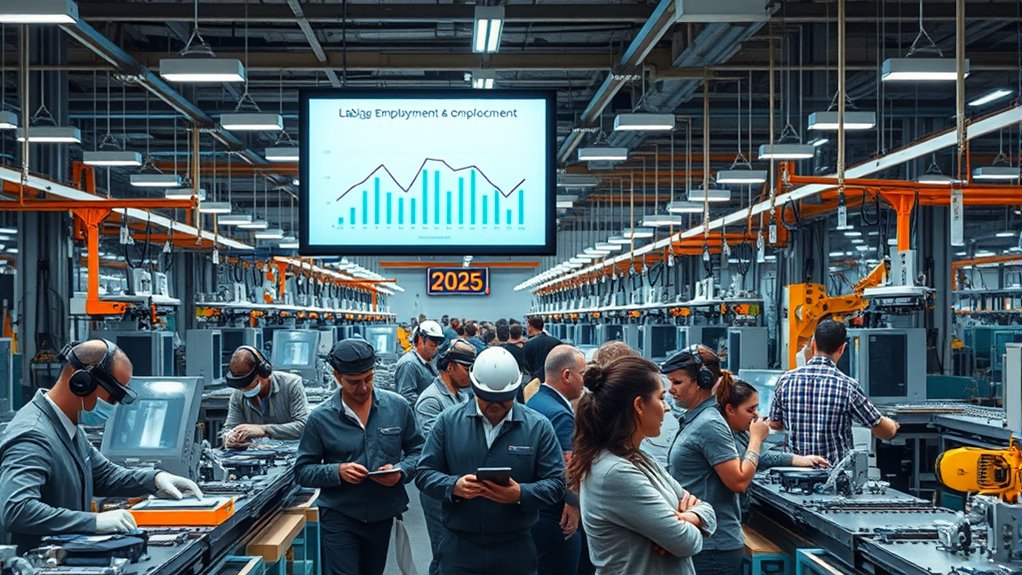In 2025, labor shortages remain a major challenge across industries, making it harder to find skilled workers. Remote work and flexible arrangements are reshaping the job market, allowing you to access new opportunities beyond traditional boundaries. Automation replaces routine tasks but requires developing new skills like digital literacy and strategic thinking. Staying adaptable and updating your skills is essential for thriving in this evolving environment—you’ll discover ways to navigate these workforce changes as you explore further.
Key Takeaways
- Persistent labor shortages across industries hinder growth and productivity despite ongoing recruitment efforts.
- Remote and flexible work arrangements expand talent pools but require digital skills and self-motivation.
- Automation replaces routine tasks, prompting workers to develop new technological and strategic skills.
- Continuous skill development and adaptability are essential for staying relevant in an evolving job market.
- Hybrid work models and technological proficiency are increasingly valued in navigating employment trends in 2025.

Despite efforts to attract and retain workers, many industries are struggling with a labor shortage that hampers growth and productivity. As you navigate the evolving job market in 2025, you’ll notice that remote work continues to reshape employment landscapes. Companies have increasingly adopted flexible work arrangements, which expand talent pools beyond geographic boundaries. This shift allows you to access a broader range of opportunities, but it also introduces new challenges. Employers are competing fiercely to attract remote workers, offering benefits and incentives that weren’t as common before. However, remote work isn’t a cure-all; it’s often accompanied by a demand for specific skills, digital literacy, and self-motivation that not every candidate possesses.
At the same time, the impact of automation is becoming more prominent. You might see routine tasks being replaced by AI and robotics, which can streamline operations and reduce the need for human labor in certain roles. While automation can help fill gaps created by labor shortages, it also forces you to adapt. Workers are expected to develop new skills, especially in technology and data analysis, to remain relevant in their roles. If you’re in a sector heavily influenced by automation, you may find yourself upskilling or shifting to more complex tasks that machines can’t handle. Automation impacts not only the number of jobs available but also the nature of those jobs, shifting the focus towards more strategic, creative, or supervisory functions.
The combination of remote work and automation impacts means you need to be flexible and proactive. Companies are increasingly valuing agility—being able to work remotely effectively while continuously learning new skills to keep pace with technological advancements. Staying current with labor market trends and understanding how to leverage automation tools can significantly enhance your employability. If you’re looking for employment or trying to retain your current position, understanding these trends is vital. You’ll want to highlight your adaptability, digital proficiency, and willingness to embrace new tools and processes. Employers are also seeking workers who can operate in hybrid environments, seamlessly shifting between remote and onsite duties.
Frequently Asked Questions
How Will Automation Impact Future Employment Opportunities?
Automation, driven by AI integration, will profoundly reshape your employment opportunities. While it may cause some job displacement, it also creates new roles requiring advanced skills. You’ll need to adapt by embracing continuous learning and developing tech-savvy expertise. Automation will streamline routine tasks, letting you focus on more complex, creative work. In this evolving landscape, staying flexible and proactive will help you thrive amidst the changes automation brings to future employment.
What Industries Will Be Most Affected by Labor Shortages?
You’ll find your industry facing unprecedented shortages, with healthcare, construction, and hospitality hit hardest due to industry-specific shortages and a slow pace of workforce diversification. These sectors might struggle to meet demands, risking delays and increased costs. To survive, you’ll need innovative strategies, embrace automation, and prioritize diverse hiring practices — because the future demands a resilient, adaptable workforce that can overcome these looming shortages.
How Can Companies Attract and Retain Skilled Workers?
You can attract and retain skilled workers by boosting employee engagement and offering competitive benefits. Focus on creating a positive work environment where employees feel valued and motivated. Provide flexible schedules, professional development opportunities, and attractive perks. Regularly recognize achievements and listen to employee feedback. By fostering a supportive culture and offering appealing benefits, you’ll inspire loyalty and draw top talent, ensuring your workforce stays strong and committed.
What Role Will Remote Work Play in Addressing Workforce Gaps?
Remote work can markedly fill workforce gaps by enabling remote collaboration and virtual onboarding, making it easier to access talent nationwide. While some believe remote work reduces productivity, evidence shows it often enhances flexibility and engagement. You’ll find that embracing remote work allows you to tap into a broader talent pool, retain skilled employees, and address staffing shortages more effectively. The key is to optimize virtual onboarding and foster strong remote collaboration.
How Might Immigration Policies Influence Labor Supply?
Immigration policies directly shape your labor supply by either expanding or restricting access to diverse talent pools. If reforms promote more inclusive immigration and workforce diversity, you’ll benefit from a broader range of skills and perspectives. Conversely, stricter laws can limit the available workforce, intensifying labor shortages. You should stay informed about policy changes, as they’ll influence your ability to attract and retain skilled workers essential for your organization’s growth.
Conclusion
As you navigate the shifting landscape of 2025’s labor market, remember that these shortages are like storms on the horizon—challenging but not unstoppable. Your adaptability and proactive approach are your compass through these turbulent times. Embrace change, develop new skills, and stay resilient. By doing so, you’ll steer your career clear of the storm, turning workforce woes into opportunities for growth and renewal. The future is yours to shape—don’t let uncertainty anchor you down.








